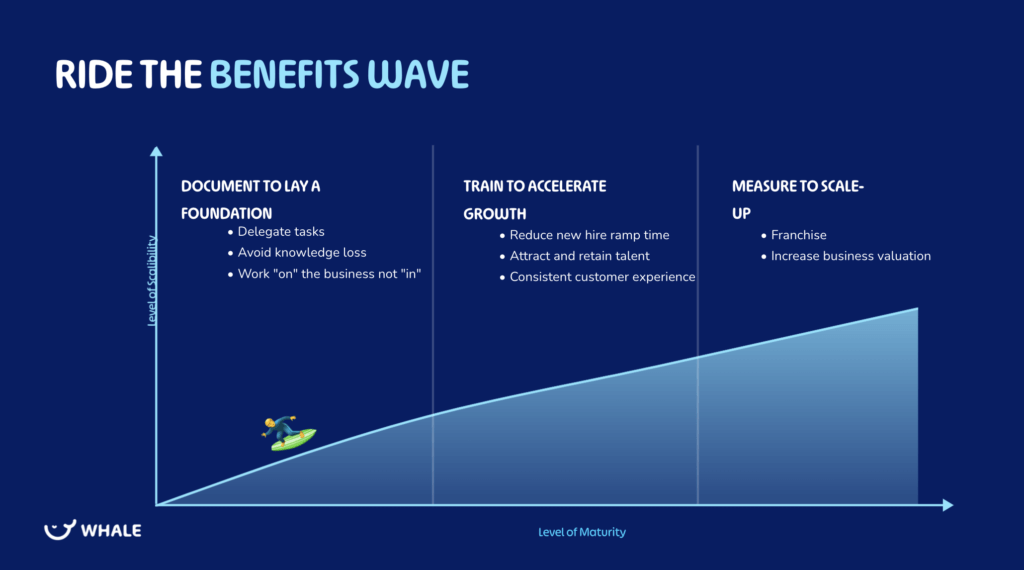How to start documenting process from scratch is probably the number one question we get asked at Whale.
We’ve never done this before, how do we start? Is it worth starting?
The answer is yes, yes and yes!
Business documentation is like planting a tree. The best time to plant a tree was 10 years ago, the next best time is today. If you haven’t started documenting your business process and processes, then you’re going to want to start today.
We don’t want to scare you but failing to document your processes not only kills productivity but also your business in the long term.
The benefits of documenting process in your business
Picture this scenario… your head of customer success plans to onboard new customers in the most fantastic and efficient way possible. This is in an effort to reduce churn and make sure that your customers stick around for the long term.
The Head CSM then explains to the team how to roll it out but then unexpectedly has to take unplanned time off due to illness. The team can’t proceed because they aren’t exactly 100% sure what to do and this is a new process that’s never been rolled out before.
What the team needs is a customer success playbook that would allow the team to move forward with the plan roll despite being short a team member for a few days.

What else can documentation do besides filling in a gap and preventing knowledge loss when a team member leaves or is out of the office?
Processes help you to;
- Delegate tasks
- Prevent knowledge loss in your company
- Work on the business and not just in it
- Reduce new hire ramp up time
- Attract and retain the best talent
- Ensure consistent customer service
- Franchise
- Increase your business valuation
- And even sell and/or exit the business when you decide to
The problem with documenting process 🕰️
But it takes too much time to start documenting from scratch, right? And besides, when there’s so much work to do, how can you stop to document process?
But it doesn’t have to take time and it doesn’t have to be an uphill battle.
Some principles to start documenting from scratch
Don’t make life difficult for you and your team. Remember these simple processes and you’ll be good to go
- Not all documentation is created equal
Use video and images to capture attention and utilize The Netflix Effect to make documents engaging.
- 50% is better than 0%
It doesn’t have to be perfect and it certainly doesn’t need to be a 70-page document (mostly because no one will read it. Just put the key steps down, and don’t forget to see point 1 above.
- Focus on common and repeatable, not exceptions
There are things that happen in your business often. For example, onboarding new customers or team members, running marketing campaigns, payroll, sales calls, and more. Focus on these things, don’t waste time trying to write a process for an activity that only happens once or twice a year. It’s not worth your time.
- Avoid going into details too soon
See point number 2 above and remember a 70-page document isn’t necessary. Your team member only needs to understand when to use the process, why, and the main steps involved.
- Use your common terminology
How do you speak in your business? What are the common terms used? Use these terms and terminology in your documentation to keep consistency in the business.
3 steps to documenting process from scratch to finish

First identify where to start 🏁
Identifying where to start documenting your business process can seem overwhelming. As a result, this is the step where most people stop.
Common advice states that companies should choose to document processes that align with the business goals. But this isn’t always as easy as it seems.
Let’s get rid of some of the overwhelm. Here are some common but easy ways to help you identify where to start documenting.
80-20 and Low hanging fruit 🍇
Start with easy processes that you use often and make a big difference, e.g., the 20% of the processes that produce 80% of the results. Think about the repetitive questions from employees and common issues and complaints from customers that need to be addressed. This is an easy place to start that aligns naturally with business goals.
Run a Team Survey
If you’re unsure of where to start, ask the team! Create a quick survey or questionnaire to ask what’s important to them. This will help you answer what the team requires to improve their game.
Use the new hire ramp-up method
How do you onboard new team hires and ensure they know what to expect and how to deliver in their role? Next time you onboard a new team member, list what you share with them and use the list to identify what processes need to be documented.
Use a delegate matrix
Do you wish, as a VP, founder, or CEO, you could hand off some of your duties? What if you could? Make a list of tasks you’d like to delegate and simply create relevant processes to delegate these tasks.
Think of the EOS Core process
What core processes do you need to run on EOS? Create a high-level map of your key business processes for clarity.
Second, document in no time at all 📓
Okay, so now it comes down to actually creating the documentation and this is where most people and companies get stuck.
But don’t panic.
There are ways to make life easier and document process from scratch in no time! We literally mean NO time!
- First, know you don’t have to do it all alone! Use subject matter experts to create documentation that is relevant to key areas of the business.
- Next time you onboard a team member, use the junior transfer method. This means getting the new team hire to document processes as they are trained by a more experienced team member. So you’re solving two tasks at the same time!
- Use a screen recorder to capture processes in video format as you go.
- Whale’s AI Assist creates documentation in seconds! And yes, we literally mean seconds. You could have processes documented in the time it takes to read this article!
Why create from scratch when you don’t have to? Use templates as a basis for your company’s SOP and process documentation.
Then, organize and centralize process documentation for scalability 📱
You will only gain a competitive advantage from your process documentation if it’s shared and followed by all team members.
Once you’ve started documenting your processes, make sure to centralize and organize them using these principles.
Use a KISS mindset 💋
We don’t mean to be difficult but KISS. This is short for Keep it Simple Stupid. We don’t mean you’re stupid. We mean that keeping it simple prevents silly mistakes. How to organize your documentation simply?
Keep it in one place and give access to the right people.
Define access levels
Who needs what and when?
This one question will help you define your access levels within your organization. That simply means that the right people will have access to the right processes at the right time.
Utilizing a tool like Whale automates this so that you don’t have to remember to share documents manually. Also, with document version control, you can see what updates have been made by whom and when.
Using a hierarchy that reflects your business structure
The simple rule of thumb is to organize your process documentation as you organize your business. For instance, what teams do you have? Marketing? Sales? Development? Finance?
Organizing your company documentation as a digital reflection of your business will make accessing things easy.
Assigning ownership & review regularly 👀
Remember how you delegated the actual documenting of the process in Step 2? Well don’t stop there. Keep subject matter experts responsible for their area of expertise and responsibility. This will not only keep team members engaged but will also keep your documentation organized and up to date.
Just as your business updates process according to how to achieve the best outcome, so too will processes need to be updated.
Remember to set regular intervals for reviewing your company documentation. Regular updates and continuous improvement are key to their effectiveness. (On Whale you can do this automatically but you can always investigate more here).
Bottom Line
In conclusion, embarking on the journey to document processes from scratch is a significant step toward organizational efficiency and long-term success.
By following the steps outlined above, you will have laid a strong foundation for creating clear, comprehensive, and accessible process documentation.
Remember, the key lies not only in documenting but also in fostering a culture of continuous improvement.
Stay open to feedback, adapt your documentation as your processes evolve, and encourage collaboration among team members.
And it doesn’t have to take time! By using these hacks you can start documenting from scratch in no time!
Remember you are not just shaping the present, but also building a sustainable framework for the future of your organization.
Happy documenting!







